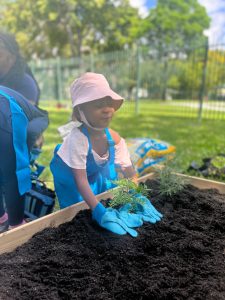By: Susana Peñaranda and Yaredly Hernández Robles, Master Gardener Volunteers, Class of ’22
Part 1: The Past – Foundations and Beginnings
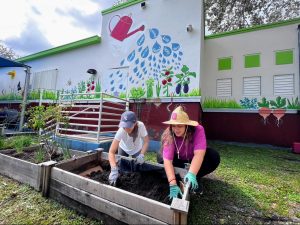 As Master Gardener Volunteer Trainees, our journey began as a personal quest for knowledge, but it quickly blossomed into something far greater—a mission to cultivate not only gardens but also young minds. We wanted to nurture a greener, more sustainable future. We both shared a love for gardening and a vision to till the soil of community impact. In the halls of the City of Miami – Department of Human Services, where our professional paths converged, we saw an opportunity to sow the seeds of change. Join us for this three-part series to learn about the past, the present, and future steps with Ready, Set, Grow!, where we will explore our journey, current achievements, and the exciting opportunities that lie ahead.
As Master Gardener Volunteer Trainees, our journey began as a personal quest for knowledge, but it quickly blossomed into something far greater—a mission to cultivate not only gardens but also young minds. We wanted to nurture a greener, more sustainable future. We both shared a love for gardening and a vision to till the soil of community impact. In the halls of the City of Miami – Department of Human Services, where our professional paths converged, we saw an opportunity to sow the seeds of change. Join us for this three-part series to learn about the past, the present, and future steps with Ready, Set, Grow!, where we will explore our journey, current achievements, and the exciting opportunities that lie ahead.
Susana’s Backstory: Finding Peace in the Backyard
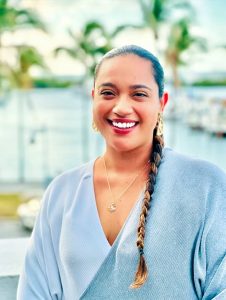 My name is Susana, and this is how a global health pandemic reshaped my connection with nature. In 2020, as my family and I endured months of uncertainty at home, the confinement left me craving for a breath of fresh air—literally. I would retreat to the backyard, with its simple set up of grass and tall shrubs to see the butterflies flutter among the space. I soon learned these were Monarch Butterflies and that realization led me down a rabbit hole of discovery. I dove into researching their dependence on milkweed as a host plant and became intrigued by their lifecycle. Eager to play a part in their story, I ventured to a nearby nursery and selected milkweed plants to introduce into our backyard.
My name is Susana, and this is how a global health pandemic reshaped my connection with nature. In 2020, as my family and I endured months of uncertainty at home, the confinement left me craving for a breath of fresh air—literally. I would retreat to the backyard, with its simple set up of grass and tall shrubs to see the butterflies flutter among the space. I soon learned these were Monarch Butterflies and that realization led me down a rabbit hole of discovery. I dove into researching their dependence on milkweed as a host plant and became intrigued by their lifecycle. Eager to play a part in their story, I ventured to a nearby nursery and selected milkweed plants to introduce into our backyard.
Within months, my children and I observed Monarchs laying their eggs on the underside of milkweed leaves. It was mesmerizing to see the small, yellow-and-black caterpillars emerge and steadily grow as they voraciously fed. These caterpillars eventually transformed into vibrant green chrysalises—a shade of green I had never seen before. After a few days of anticipation, a butterfly emerged.Our fascination with these creatures led us to learn how to distinguish between males and females. By 2021, we had released over 20 Monarchs into the world. This experience not only beautified our once plain yard but also ignited a passion for understanding the vital role of pollinators in our ecosystem. Inspired by the increased visits from butterflies, bees, and birds attracted by milkweeds, and added zinnias and sunflowers, I embarked on a journey to learn more about edible gardening. If I could grow flowers, I could grow tomatoes too, right?
Yaredly’s Backstory: Reconnecting with Nature
 While COVID-19 was a daunting and dark time for many, I found light in nature. Amidst the pandemic, I decided to turn off the TV and announced to my husband that we were taking a trip to Homestead, FL, to find a nursery and buy plants. By that same afternoon, our small apartment balcony was transformed into a green oasis. I repotted seedlings of Thai basil, chives, rosemary, peppers, thyme, and romaine lettuce. I also arranged a newly acquired curry tree, butterfly pea, and other plants to create a lush, vibrant space.
While COVID-19 was a daunting and dark time for many, I found light in nature. Amidst the pandemic, I decided to turn off the TV and announced to my husband that we were taking a trip to Homestead, FL, to find a nursery and buy plants. By that same afternoon, our small apartment balcony was transformed into a green oasis. I repotted seedlings of Thai basil, chives, rosemary, peppers, thyme, and romaine lettuce. I also arranged a newly acquired curry tree, butterfly pea, and other plants to create a lush, vibrant space.
A few months into tending my new balcony garden, I began to notice that with the beauty of plants often comes the challenge of pests. My Everglades tomato plant became the first victim, as I spotted tiny aphids clustering on its leaves. Determined to avoid chemical or unnatural pesticides, I delved into research and discovered the wonders of neem oil. Just half a teaspoon diluted in a spray bottle worked wonders, eradicating the aphids and restoring my plant’s health. This natural solution not only solved the problem but also deepened my appreciation for sustainable gardening practices.
However, my battle with aphids didn’t end there. When the pests returned, this time targeting my beloved cachucha pepper plant, I knew I needed to step up my game. The infestation was more severe, so in addition to neem oil, I sought out a more proactive approach. A visit to a local nursery introduced me to the concept of biological pest control, and I left with a praying mantis egg case in hand. Using a piece of twine, I carefully attached the egg case to a branch, and within about two weeks, I was rewarded with an unforgettable sight. One morning, I watched as tiny praying mantises emerged, leaping from the egg case like little ninjas, ready to take on the aphids. It was an incredible experience that not only brought joy but also reinforced the harmonious balance of nature.
That first trip to Homestead changed my entire outlook on what COVID meant. Instead of watching the news and counting the death tolls, I chose to focus my energy on reconnecting with nature, learning about the healing properties of plants, and taking care of my immune system by nurturing my mental, physical, and emotional health. It was then that I truly understood my grandmother’s wisdom about nature being the best teacher one could have. This experience sparked a profound realization in me: I needed to find a way to share the transformative power of nature with others.
We Had a BIG Idea!
As employees of the Department of Human Services Administration Office, we quickly transitioned to remote work during the pandemic. As restrictions eased and normalcy returned, we resumed our in-office duties and found that the Child Learning Centers we oversee had reopened. Children were back in classrooms, but we noticed changes: many were no longer accustomed to outdoor activities. Recognizing the importance of outdoor time and physical activity after prolonged indoor confinement, we prioritized providing these opportunities.
We envisioned the enriching experience of connecting children with nature through gardening. What began as a butterfly garden idea for beautifying the Learning Centers soon expanded. We realized its potential to integrate education on nutrition and sustainability, transforming it into a comprehensive learning endeavor. Thus, the Ready, Set, Grow! initiative was born, aimed at nurturing a passion for nature, promoting healthy lifestyles, and instilling sustainable practices through hands-on gardening activities.
It was here that the vision for the Ready, Set, Grow! initiative took root—a program designed to engage our community in a journey of gardening and sustainable living. From pitching our ideas to aligning them with educational accreditation standards, every step of the journey has been met with an opportunity to learn and to make a difference. Fast forward to today, and our initiative has flourished into community engagement, nutrition education, and eco-conscious practices. Each moment has promoted fostering happier and healthier communities and the power of collective action plans.
Our Journey as Master Gardener Trainees
In 2022, we enrolled in UF’s 12-week Master Gardener Volunteer Program in Miami-Dade County. The program was a rewarding and enlightening experience for us. From the outset, we were drawn to this opportunity to deepen our passion for gardening while giving back to our community. The program provided us with a structured curriculum that covers a wide array of topics essential to horticulture and sustainable landscaping. Learning about plant biology, soil health, integrated pest management, and water conservation has not only expanded our knowledge base but has also equipped us with practical skills that we can apply in our own gardens (and share with others).
One of the most valuable aspects of our journey has been the opportunity to work alongside experienced Master Gardener Volunteers and Extension Agents. Their guidance and mentorship have been instrumental in our learning process, allowing us to gain hands-on experience in various gardening projects and community outreach initiatives.
The Master Gardener Volunteer training built our confidence in implementing our big idea. It not only taught us botany and horticultural practices but also helped us understand crucial elements (such as the hardiness zone for South Florida). This knowledge was essential for building a successful garden in our region. The training introduced us to native and local plants that thrive in our zone, both edible and ornamental, and the South Florida growth calendar, ensuring we planted during the right seasons. Access to resources on the UF/IFAS website made a significant difference.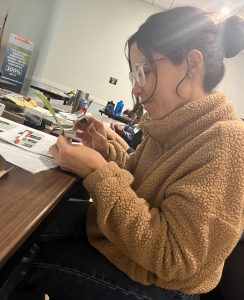
We also learned companion planting techniques. By implementing them, we learned that we could harness natural pest control, enhance nutrient uptake, and optimize spatial interactions, resulting in higher yields and more robust plant growth. For instance, we began pairing beans with most vegetables and herbs, tomatoes with parsley and basil, and eggplants with beans and marigolds. We also experimented by creating a sunflower patch.
Guided by the UF/IFAS Grow Calendar for South Florida, our plant selection included herbs like basil, thyme, rosemary, and parsley, as well as fruits and vegetables like tomatoes, lettuce, bok choy, snap beans, and strawberries. We also included pollinator plants such as zinnias, marigolds, cosmos, milkweeds, and sunflowers. These choices ensured the right plants were in the right places, promoting a sustainable and thriving garden.
The Master Gardener Volunteer training was vital in helping us design a garden for ease and sustainability. We learned proper pruning and watering techniques, which we incorporated into the curriculum for regular care. Sustainability practices, such as composting garden waste to create nutrient-rich soil and harvesting seeds from mature plants for future planting cycles were also emphasized.
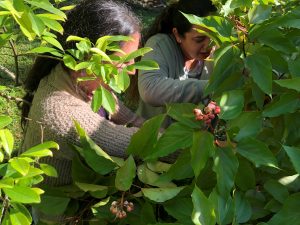 Our training equipped us with the knowledge to design a garden that is both practical and sustainable. We incorporated pruning and watering techniques into our curriculum and emphasized practices like composting and seed harvesting. This training was crucial in realizing the Ready, Set, Grow! initiative.
Our training equipped us with the knowledge to design a garden that is both practical and sustainable. We incorporated pruning and watering techniques into our curriculum and emphasized practices like composting and seed harvesting. This training was crucial in realizing the Ready, Set, Grow! initiative.
Stay tuned for Part two of our series, “The Present—Implementing Change”.
-Susana and Yaredly
If you’re interested in getting involved with Ready, Set, Grow!, reach out to us at readysetgrowinitiative@gmail.com
Follow us on Instagram: @readysetgrowinitiative and @thehappyseedsproject
 14
14
